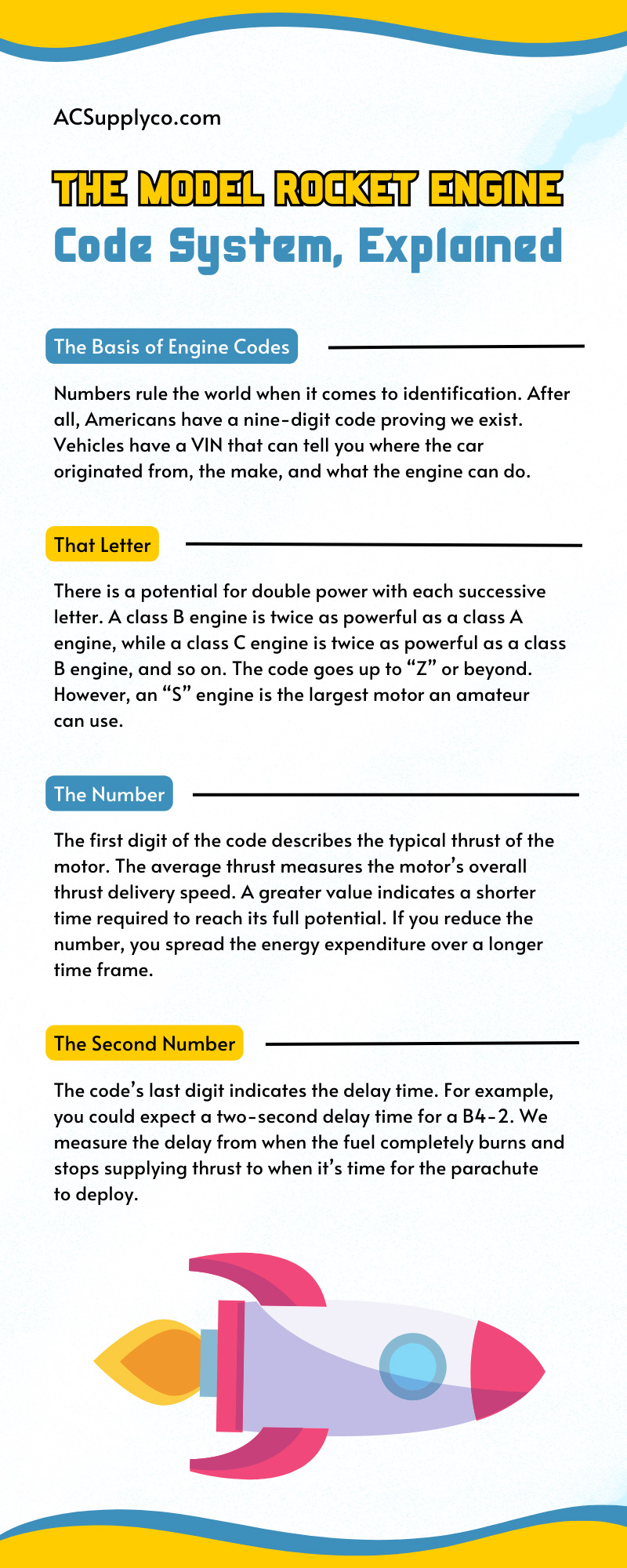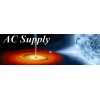Learning more about model rockets can help us better control
them. The model rocket engine code exists because it tells us about the
rocket’s capabilities in the simplest way possible. But the novice may not
fully grasp the significance of the letters and numbers attached to the model.
We’re here to explain the model engine code system to
lessen confusion and ensure you know what you’re getting with your rocket,
allowing you to explore this wonderful hobby safely.
The Basis of Engine Codes
Numbers rule the world when it comes to identification.
After all, Americans have a nine-digit code proving we exist. Vehicles have a
VIN that can tell you where the car originated from, the make, and what the
engine can do.
Every motor used in a model rocket has an engine code
printed on it. While building and readying your rocket for launch, you could see
a notation such as “B4-2”. For continuity, the B4-2 will be our example
throughout, although several codes describe different engines.
That Letter
The first designation is “B,” representing the engine’s
power concerning Newton seconds. Let’s return to the automotive sector for an
analogy that explains this further.
The “B” in the code tells us the total impulse of the engine.
Take
this chart and cross-reference the letter to find the total impulse of the
rocket. For example, our “B” rocket has a total impulse from 2.51-5.00
There is a potential for double power with each successive
letter. A class B engine is twice as powerful as a class A engine, while a
class C engine is twice as powerful as a class B engine, and so on.
The code goes up to “Z” or beyond. However, an “S” engine is
the largest motor an amateur can use. You’ll need certification and signed
waivers to ignite it, so don’t expect to send one skyward anytime soon.
The Number
The first digit of the code describes the typical thrust of
the motor. The average thrust measures the motor’s overall thrust delivery
speed. A greater value indicates a shorter time required to reach its full
potential. If you reduce the number, you spread the energy expenditure over a
longer time frame.
A pair of “B” rockets are comparable regarding the total
impulse; however, a B6 will max out its energy far quicker than a B3 rocket.
The B3 engine uses significantly less thrust, leading to a longer burn time. In
summary, the higher the figure, the quicker it’ll go. Since aerodynamic drag
increases with the square of the rocket’s velocity, a B4 rocket can achieve
higher speeds than a B6 rocket.
The Second Number
The code’s last digit indicates the delay time. For example,
you could expect a two-second delay time for a B4-2. We measure the delay from
when the fuel completely burns and stops supplying thrust to when it’s time for
the parachute to deploy.
Your rocket must move slowly when the parachute deploys;
therefore, the delay time is crucial. If it goes too quickly, the chute won’t
do its job. Too much speed will make your model rocket have a crash landing. If
there’s too much acceleration, the parachute cannot deploy without destroying
itself.
Parachute deployment is safest when the rocket is moving
slowly. Booster stages benefit most from engines with a delay time of zero.
Codes for engines that finish in “P” indicate a “plugging” configuration, which
incurs no waiting time or ejection fee. A stopper in the front ensures that no
hot gases may escape.
Your Preferred Type
If speed is your top priority in rocketry, picking the
rocket engine with the highest thrust is the way to go. Choosing a motor
at the bottom end of the spectrum regarding thrust also comes with a cost. A
lower speed value indicates a slower rate of travel. The rocket’s stability
during launch will suffer as a result.
Weathercocking can often occur with slow rockets.
Weathercocking is when the wind manipulates an object based on where it’s
blowing. As a result, they tend to fly more horizontally than vertically. Once
again, they don’t reach the same heights, although they may cover much more
ground.
Rocketry is full of compromises. You can never get what you
desire without giving something else up.
Different Motors for Model Rockets
The propulsion of model rockets comes from motors. The
motors are disposable, but the cases are often reusable. The components of
model rocket motors are fuel and oxidizers. These two components are flexible
yet essential for supplying the most accurate thrust.
Black Powder
Combining charcoal with sulfur and
potassium nitrate yields black powder. Compared to other propellants,
black powder is inexpensive and readily available. The paper casing on these
motors sets them apart from similar products.
Clay, black powder, and paper are cheap and simple building
blocks. The ignition is reliable since they are highly combustible. High
temperatures alone can lead to ignition, allowing the motors to start without open
flames.
Composite
The composite motor’s propellant is a chemical cocktail of
fuel and oxidizer. A composite rocket can be for singular use, or you can opt
for one you can reassemble. The energy density of composite motors is greater.
Large rockets employ chemicals with a similar composition.
Since the composite is pliable, it is unlikely to crack on
impact. In other words, the material is very sturdy, resulting in fewer damaged
rockets and more successful takeoffs. They come in various power ratings and
may even have different colored flames for a more dramatic effect during the
launch. s
Low Power
Motors with lower power ratings (A, B, C, and D) are
generally 18-24mm in size.
Moderate Power
D, E, F, and most G motors are “mid-power” motors running
from 24mm to 29mm.
Brute Power
Few F and G classes, but all H and higher classes, have a
thrust greater than 80. They usually apply to lenses of 29mm and above. One
must be at least 18 years old to use these motors.
Selecting a Motor
Numerous manufacturers provide model rocket motors, which is
why it’s paramount to explain the model rocket engine code system. But
generally, novices should start with an Estes rocket—we carry many model
rocket engines for sale at AC Supply.
Estes mostly produces black powder propellants for their motors, but they also make a small number of composite propellants. The sizes are 14 A through G. Rocketeers may choose from many options here. Following our breakdown of model rocket engine codes, feel free to peruse our selection at your leisure.



